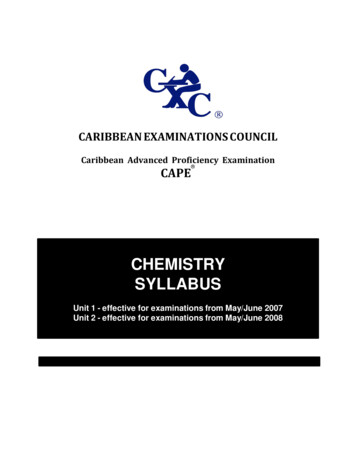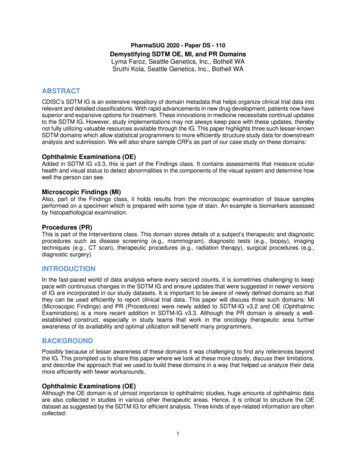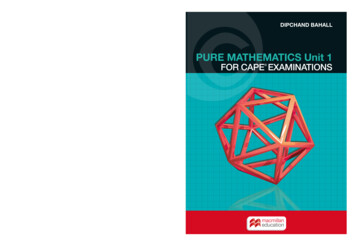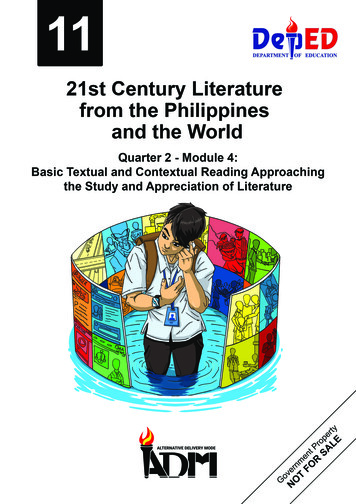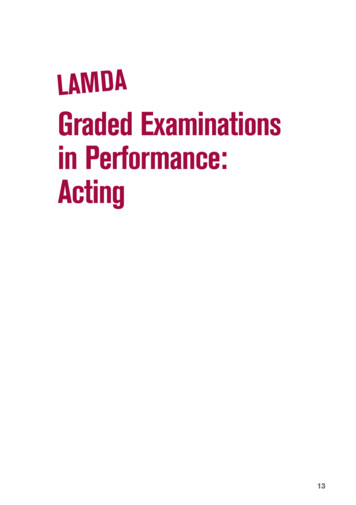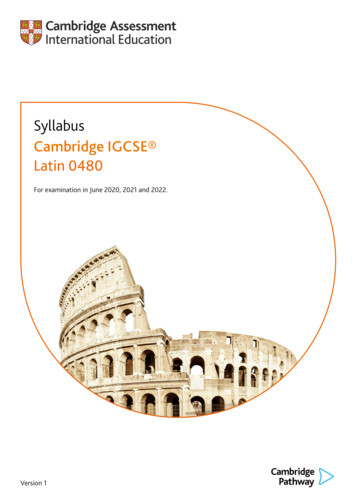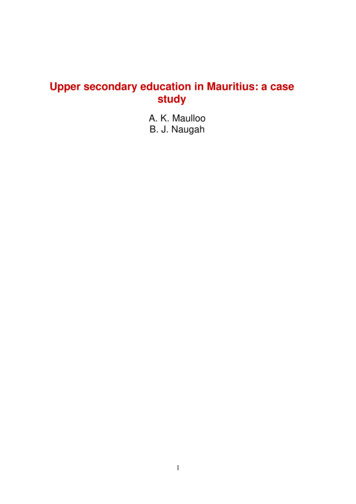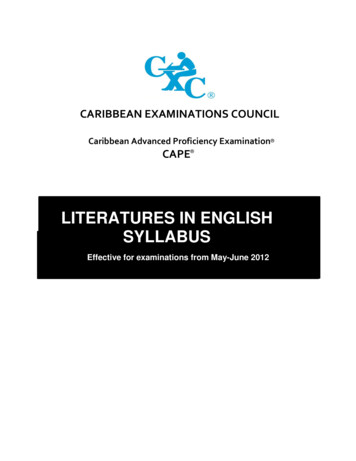
Transcription
CARIBBEAN EXAMINATIONS COUNCILCaribbean Advanced Proficiency Examination CAPE LITERATURES IN ENGLISHSYLLABUSEffective for examinations from May-June 2012CXC A15/U2/10
Published by the Caribbean Examinations CouncilAll rights reserved. No part of this publication may be reproduced, stored in a retrieval system, or transmittedin any form, or by any means electronic, photocopying, recording or otherwise without prior permission ofthe author or publisher.Correspondence related to the syllabus should be addressed to:The Pro-RegistrarCaribbean Examinations CouncilCaenwood Centre37 Arnold Road, Kingston 5, JamaicaTelephone Number: 1 (876) 630-5200Facsimile Number: 1 (876) 967-4972E-mail Address: cxcwzo@cxc.orgWebsite: www.cxc.orgCopyright 2010 by Caribbean Examinations CouncilThe Garrison, St Michael BB14038, BarbadosCXC A15/U2/10
ContentsRATIONALE . 1AIMS. 1AREAS OF STUDY . 2GENERAL OBJECTIVES . 2SKILLS AND ABILITIES TO BE ASSESSED . 3PRE-REQUISITES OF THE SYLLABUS . 4STRUCTURE OF THE SYLLABUS . 4APPROACHES TO TEACHING THE SYLLABUS . 4RESOURCES. 5UNIT 1 AND UNIT 2MODULE 1: DRAMA. 6MODULE 2: POETRY . 12MODULE 3: PROSE FICTION . 17PRESCRIBED TEXTS – UNIT 1 . 20PRESCRIBED TEXTS – UNIT 2 . 23OUTLINE OF ASSESSMENT . 24REGULATIONS FOR PRIVATE CANDIDATES . 31REGULATIONS FOR RESIT CANDIDATES . 31ASSESSMENT GRID . 31GLOSSARY OF LITERARY CONCEPTS OFTEN USED IN THE LITERATURES INENGLISH EXAMINATION . 32CXC A15/U2/10ii
GLOSSARY OF BEHAVIOURAL VERBS USED IN THE LITERATURES IN ENGLISHEXAMINATIONS . 35APPENDIX 1 – PRESCRIBED POEMS FOR UNIT 1. 37APPENDIX II – PRESCRIBED POEMS FOR UNIT 2 . 38This document CXC A15/U2/10 replaces CXC A15/U2/05 issued in 2005Please note that the syllabus has been revised and amendments are indicated by italics.Issued 2001Revised 2005Revised 2010Please check the website, www.cxc.org for updates on CXC‟s syllabuses.CXC A15/U2/10iii
TIntroductionThe Caribbean Advanced Proficiency Examination (CAPE) is designed to provide certification of theacademic, vocational and technical achievement of students in the Caribbean who, having completed aminimum of five years of secondary education, wish to further their studies. The examinations addressthe skills and knowledge acquired by students under a flexible and articulated system where subjects areorganized in 1-Unit or 2-Unit courses with each Unit containing three Modules. Subjects examined underCAPE may be studied concurrently or singly.The Caribbean Examinations Council offers three types of certification. The first is the award of acertificate showing each CAPE Unit completed. The second is the CAPE diploma, awarded to candidateswho have satisfactorily completed at least six Units, including Caribbean Studies. The third is the CAPEAssociate Degree, awarded for the satisfactory completion of a prescribed cluster of seven CAPE Unitsincluding Caribbean Studies and Communication Studies. For the CAPE diploma and the CAPEAssociate Degree, candidates must complete the cluster of required Units within a maximum period offive years.Recognised educational institutions presenting candidates for CAPE Associate Degree in one of the ninecategories must, on registering these candidates at the start of the qualifying year, have them confirm inthe required form, the Associate Degree they wish to be awarded. Candidates will not be awarded anypossible alternatives for which they did not apply.CXC A15/U2/10
Literatures in English RATIONALELiterature is arguably the most vital register of the major ideas, concerns, feelings, aspirations, and hopesof the communities out of which it comes. To know literature is, therefore, to be familiar with thecommunities that have produced it. To be familiar with communities is to understand how theyresemble each other and how they differ from each other; that is, to understand the uniqueness of each. In arapidly shrinking world this understanding becomes increasingly crucial and urgent as each community seesitself, on the one hand, as part of a large human family and, on the other, as a unique cultural context.Mediating between the Community and literature is the artist who interprets facets of the life of thecommunity in imaginative structures. These structures encompass the personal, social, and the universal;consequently, the study of literature promotes understanding of both the individual and mankind in general.Nothing that is human is foreign to literature, for literature participates with other disciplines in commentingon, clarifying, and enhancing the human condition. To study literature, therefore, is to understand how thehuman imagination, the creative faculty, works as it responds to diverse experiences.Through its varied treatment of the facets of human experience, literature uniquely prepares individuals forliving and working in the world. The study of literature provides the individual with analytic, organisationand communicative and skills of enquiry as defined in the UNESCO Pillars of Learning that will enable themto succeed in their academic careers and the world of work. These skills create career opportunities in avariety of fields, including education, the media, human resource management, corporate communications,advertising, and law.The Caribbean is a complex historical, social, and cultural context, producing a rich and varied literaturewhich has earned a crucial place in the global family of literatures in English. Consequently, that literatureforms an important aspect of the study of Literatures in English for this Caribbean-based examination.Significantly, it also assists in moulding the ideal Caribbean person. Such a person displays a high level ofself-esteem, lives in harmony with the environment, values human life, and takes pride in our cultural heritageand diversity The Caribbean Education Strategy (2000). AIMSThe syllabus aims to:1.develop an understanding of the nature and function of literature;2.develop an understanding of the methods of literary study;3.encourage critical reading, interpretation, and evaluation;4.encourage an understanding that there are various acceptable interpretations of a literary work;5.encourage an appreciation of and an informed personal response to literature;6.sensitise individuals to the needs and concerns of self, of others, and of the larger communityCXC A15/U2/101
AREAS OF STUDYThe areas of study for Unit 1 and Unit 2 are indicated in the following table.Unit 1Module 1Dramaa. Shakespearei. Comediesii. HistoriesModule 2Poetrya. BritishModule 3Prose Fictiona. Caribbeanb. Americanb. British/American/Postcolonial (otherthan Caribbean)c.Unit 2a. Shakespearei. Tragediesii. RomancesPostcoloniala. Caribbean Poetrya.Britishb. Americanb. Modern Dramac.Postcolonial GENERAL OBJECTIVESOn completion of each Unit, students should:1.develop a sensitivity to the ways in which writers manipulate language to convey meaning;2.understand and demonstrate an ability to use the vocabulary of literary criticism at an appropriatelevel;3.understand the differences in style and structure among the literary genres;4.develop the ability to critique works of different genres written in different periods from differentcultures;5.understand the relationship between form and content;6.develop competence in critical thinking;7.develop informed, sensitive, and balanced responses to the complexity of human nature as portrayedin literary works;8.develop the ability to discern and grasp attitudes, values, feelings, and ideas illustrated in literaryworks;9.develop the ability to write coherent, well-reasoned argumentative essays;10.develop the ability to write informed and analytical essays on literature;11.develop an appreciation for varying critical interpretations of works of literature.CXC A15/U2/102
SKILLS AND ABILITIES TO BE ASSESSEDThe skills and abilities which students are expected to have developed on completion of this syllabus aregrouped under three main headings:(i)(ii)(iii)Knowledge and Understanding;Application of Knowledge;Organisation of Information.Knowledge and UnderstandingThe Assessment will test:(i)familiarity with the primary (prescribed) texts;(ii)familiarity with secondary sources;(iii)familiarity with the features of genres;(iv)familiarity with, and the proper use of the vocabulary specific to genres;(v)understanding of the relationship between form and content within genres.Application of KnowledgeThe Assessment will test:(i)the ability to analyse, evaluate, and synthesise knowledge;(ii)the ability to write a clear thesis, select appropriate evidence and use sound logic;(iii)the appropriateness of the information selected;(iv)the ability to present a reasonable conclusion based on evidence provided.Organisation of InformationThe Assessment will test the effective use of the mechanics of essay writing which includes:(i)opening paragraph with clear thesis which introduces main points of argument;(ii)middle paragraphs which develop the points outlined in opening paragraph;(iii)final paragraph which brings argument to a reasonable conclusion;CXC A15/U2/103
(iv)transition words between sentences and paragraphs;(v)formal syntactic structures;(vi)correct grammar;(vii)use of language. PRE-REQUISITES OF THE SYLLABUSAny person with a good grasp of the Caribbean Secondary Education Certificate (CSEC) English B syllabus,or its equivalent, should be able to pursue the course of study defined by this syllabus. STRUCTURE OF THE SYLLABUSThe Literatures in English syllabus comprises two Units, each containing three Modules corresponding to thethree literary genres: Drama, Poetry, and Prose Fiction. These Modules are synonymous with the profiledimensions to be assessed. These Modules may be studied in any order.Each Unit incorporates the subject core which comprises the knowledge and understanding derived from arange of readings; concepts and skills in literary study, and related assessment objectives. The corecomprises four texts drawn from a range of historical periods between 1370 and the present day. Allprescribed core texts are works originally written in English. The core requires students to study, at least, thefollowing:(i)one play by Shakespeare;(ii)one work of Caribbean literature;(iii)one work of poetry;(iv)one work of prose fiction.Each Unit requires a study of a minimum of four texts.Students are expected to spend at least 50 hours on each Module.CXC A15/U2/104
APPROACHES TO TEACHING THE SYLLABUSThe study of literature requires wide reading; those who read most widely are likely to do best. Teachers,therefore, should encourage students to read as much as possible. They should encourage students to readmore than the required texts. Knowledge of texts other than those prescribed always helps.Teachers should advise students in the selection and use of information available on the Internet. Since thismaterial is uneven in quality and usefulness, teachers should guide students in choice and use.Similarly, teachers, wherever possible, should encourage the use of film and audio material as avenues to thebetter understanding of the texts. Teachers should always encourage critical appraisals of media material.This constitutes a valuable teaching resource. It is imperative, though, that teachers remind students thatneither film nor performance nor audiotape ought to be used as a substitute for the text. The examinationtests primarily the knowledge and understanding of the prescribed texts.Development of a facility in writing is incremental; the more often you write the more proficient you becomeat writing. Therefore, teachers should afford students ample opportunity to enhance their proficiency in thewriting of coherent argumentative essays.The list of elements and concepts under Content in each Module is not exhaustive. Each is meant to be anadequate guide to the study of literature at this level. RESOURCES(for use throughout the Units)Beach, R., Appleman,Teaching literature to adolescents. Lawrence Erlbaum Associates. NewJersey: Lawrence Erlbaum Associates, 2006.D. Hynds, S. & Wilhelm,J. Craig, D. R.Teaching language and literacy: Policies and procedures for vernacularsituations. Revised. Kingston: Ian Randle Inc., 2006.Griffith, K.Writing essays about literature: A guide and style sheet. (7th ed.) Boston:Thomson Wadsworth. 2006.Lazar, G.Literature and language teaching: A guide for teachers and trainers.Cambridge: University Press, 1993.Merriam Webster’s Readers Handbook Massachusetts: Merriam-Webster Inc., 1997.Warrican, S. J.,Spencer-Ernandez, J.& Strategies for the teaching of reading and writing: A practical guide forteachers of Caribbean children. Kingston: Joint Board of Teacher EducationFoundation, University of the West Indies, 2006.CXC A15/U2/105
UNIT 1 AND UNIT 2MODULE 1: DRAMASPECIFIC OBJECTIVESStudents should be able to:1.explain how meaning is conveyed through the structure of the chosen genre, for example, comedy,history, tragedy, or romance;2.assess how meaning is expressed through the playwright‟s choice of language, literary devices andthe use of structural elements and features of drama;3.assess how meaning is expressed through stage conventions such as costume, lighting, sound effectsand stage props;4.analyse the contexts in which the chosen plays are written;5.analyse dramatic works from different cultural and historical contexts;6.examine how meaning is affected by context;7.discuss their own views and the views of critics;8.write informed and independent opinions and judgements about the chosen plays.CONTENTFor both Unit 1 and Unit 2, the focus of study should include the following:1.Elements of .(v)Complication.(vi)Climax.(vii)Denouement (unravelling/resolution of the plot).CXC A15/U2/106
UNIT 1 AND UNIT 2MODULE 1: DRAMA (cont’d)2.3.(viii)Peripeteia (reversal of fortune).(ix)Characterisation.(x)Protagonist and Antagonist.(xi)Main plot, subplot.Forms of e.(v)Tragi-comedy.(vi)Theatre of the Absurd.(vii)Satire.(viii)Farce.(ix)Modern drama.(x)Melodrama.Features of Aside.(v)Set.CXC A15/U2/107
UNIT 1 AND UNIT 2MODULE 1: DRAMA (cont’d)4.5.(vi)Stage direction.(vii)Stage conventions [costume, lighting, sound effects, movement, (stage motion, entrance,exit), stage position (centre-stage, up stage, down stage) backdrops and props].(viii)Chorus.(ix)Dramatic unities (time, place and action).(x)Disguise.Literary matic and tragic irony.(v)Juxtaposition.Literary viii)Cultural.CXC A15/U2/108
UNIT 1 AND UNIT 2MODULE 1: DRAMA (cont’d)6.Views of different critics.7.Issues explored through drama.Suggested Teaching and Learning ActivitiesTo facilitate students’ attainment of the objectives of this Module, teachers are advised to engage students inthe teaching and learning activities listed below.1.Encourage students to read the plays on their own and formulate personal responses to the plays.2.Take students on a tour of a local theatre where they can acquaint themselves with various featuresof the theatre environment.3.Provide an introductory lecture on features of Elizabethan and other kinds of theatre and drama;and invite persons involved in theatre such as local actors, directors, to make presentations ondifferent aspects of drama, for example, the importance of costumes, lighting, and the use of stageprops.4.Show film versions or video recordings of the plays under study and critically evaluate how thesecan alter, modify, or enhance students’ understanding and appreciation of the plays.5.View and critically appraise a live performance.6.Play audio tapes of the plays (where these are accessible) and critically evaluate how these dramaticreadings can alter, modify, or enhance students‟ understanding of the plays.7.Provide introductory lectures on the cultural, social, and literary contexts in which the plays werewritten.8.Have students dramatise specific scenes in order to critically evaluate dramatic techniques andelements in relation to themes and character development.9.Arrange for dramatic readings of significant scenes to facilitate student participation and to developsensitivity to the performance aspect of drama (seeing the play as more than a text).CXC A15/U2/109
UNIT 1 AND UNIT 2MODULE 1: DRAMA (cont’d)10.Encourage role playing to enhance students‟ understanding and interpretation of the characters in theplays.11.Encourage debates, discussions, oral presentations, and critical appraisals of key issues and aspectsof the plays.12.Encourage debates of different interpretations of the plays.13.Urge students to direct dramatic scenes. For example, students can watch the same scene of a playin two or three different productions and based on their own reading of the play debate the merits ofeach director’s interpretation.14.Encourage students to write dramatic pieces and dramatise them.15.Have students practise writing essays which show evidence of an understanding of the vocabularyspecific to drama, and which present and defend clear positions in response to given stimuli.16.Have students engage in debates about differing interpretations of a play. For example, students canwatch the same scene from two or three different productions (film versions) and based on their ownreading of the play debate the merits of each director’s interpretation.17.Have students write evaluations of differing interpretations, providing evidence to support theirviews.18.Divide students into groups and ask each group to identify textual evidence from their own readingof the play to refute and/or defend in writing a selected statement from a critical interpretation of aplay.RESOURCESAbrahms, M. H.A Glossary of Literary Terms. Wadsworth Publishing, 2008.Gordon, R.How to Study a Play, London: Macmillan, 1991.Noel, K.Carlong Caribbean Drama. Longman, 2001.Peck, J. and Coyle, M.How to Study a Shakespeare Play, London: Palgrave, 1995.Literary Terms and Criticism (3rd Edition), London: Macmillan, 2002.Pickering, K.CXC A15/U2/10How to Study Modern Drama, London: Macmillan, 1990.11
Stevens, C.A Guide to Dramatic Elements and Style: Drama grades 7 – 9, WestonWatch, 2000.Stone, J.Theatre, (Studies in West Indian Literature), London: Macmillan, 1994.Teaching ShakespeareInstitutionCXC A15/U2/10Shakespeare Set Free: Teaching Twelfth Night and Othello, New York:2006.12
UNIT 1 AND UNIT 2MODULE 2: POETRYSPECIFIC OBJECTIVESStudents should be able to:1.discuss the relationship between elements of sound (alliteration, consonance, sibilance and rhyme)and sense (meaning);2.assess the importance of point of view and the difference between the persona, the speaker, and thepoet;3.explain how meaning is expressed through the poet‟s choice of language, literary devices, andstructural elements commonly found in poetry, such as image, symbol, alliteration, assonance, metre,lineation, and rhyme;4.identify a range of different forms of poetry and their characteristics;5.assess the relationship between structure and meaning, that is, how the poet organises his poem toobtain the desired meaning;6.analyse the context in which the chosen poems are written in order to appreciate relationshipsbetween context and meaning;7.discuss their own views and the views of critics;8.write informed and independent opinions and judgements about the chosen poems.CONTENTFor both Unit 1 and Unit 2, the focus of study should include the following:1.Elements of .(v)Diction.(vi)Tone.(vii)Mood.CXC A15/U2/1013
UNIT 1 AND UNIT 2MODULE 2: POETRY (cont’d)2.3.4.Literary my.(xii)Juxtaposition.(xiii)Irony.Point of view(i)Speaker.(ii)Persona.(iii)Poet.Forms of poetry(i)Ballad.(ii)Sonnet.(iii)Lyric.CXC A15/U2/1014
UNIT 1 AND UNIT 2MODULE 2: POETRY (cont’d)5.(iv)Ode.(v)Terza Rima.(vi)Dramatic Monologue.(vii)Blank Verse.(viii)Free Verse.(ix)Villanelle.Literary viii)Cultural.6.The views of different critics.7.Issues explored through poetry.CXC A15/U2/1015
UNIT 1 AND UNIT 2MODULE 2: POETRY (cont’d)Suggested Teaching and Learning ActivitiesTo facilitate students’ attainment of the objectives of this Module, teachers are advised to engage students inthe teaching and learning activities listed below.1.It is important to show students how much they already know about poetry. Read poems aloud tostudents and have them describe their response.2.Scan individual words. (For example, “instill” is an iamb; “chutney” is a trochee; “airfare” is aspondee; “beautiful” is a dactyl’ and “intervene” is an anapest. Words keep their normal stressesin poetry). Mark the stresses in simple iambic poems, for instance, Lewis Carroll’s “The MadGardener’s Song” or have students bring in lyrics from music of interest to them, for example,calypso, rap, dub, rock, chutney, zouck. Analyse the rhythm. Mark the stresses.3.Discuss types of metre (Duple metre – iambic, trochaic, spondaic, triple metre – dactylic,anapestic).4.Have the whole class parody a verse with regular rhythm, for example, “The Mad Gardener‟s Song”.Let each student write one, read it aloud, and have students discuss whether the rhythm is correct.Discuss the rhymes in these examples. Assist students to parody other forms, limericks, for instance.5.Discuss sample types of form, for example, ballad, hymn, and sonnet. Most forms should be taughtas they are encountered, as should most elements of poetry.6.Show students that poets do write sentences and that these sentences are meaningful units which mayrun through several lines or even stanzas. Poets also use punctuation marks for poetic effect andchange word order for poetic reasons.7.Divide class into small groups. Each group should read aloud and discuss the same poem. Eachgroup should then report its own interpretation to the class. Discuss the differences and reasons forthe interpretations.8.Divide students in groups and ask them to find evidence in a poem to support differinginterpretations of the same poem. For example, Edward Baugh’s poem. “A Carpenter’s Complaint,”simple statements such as “This poem is about death” or “This poem is about tradition” or “Thispoem is about grief” might be used.9.Ask each student after group discussion to develop a paragraph on one part of their argument insupport of the interpretation. Together the group would have produced one interpretation. After allthe groups have presented, you can have open discussion with challenges and/or further support.10.Have students research the social and historical context in which the poems were written.11.Have students find, share, and discuss critical essays on various poems.12.Have students practise writing essays which show evidence of an understanding of the vocabularyspecific to poetry, and which present and defend clear positions in response to given stimuli.CXC A15/U2/1016
UNIT 1 AND UNIT 2MODULE 2: POETRY (cont’d)RESOURCESBreiner, L.An Introduction to West Indian Poetry, Cambridge: Cambridge UniversityPress, 1998.Eagleton, T.How to Read a Poem, Willey – Blackwell, 2006.Maxwell, R.J.Meiser, M. J.&Teaching English in middle and secondary schools. (3rd ed.) New Jersey:Merrill Prentice Hall, 2005.Peck, J.How to Study a Poet, London: Macmillan, 1992.Perrine L.Sound and Sense: An Introduction to Poetry, (12th Ed). , Thomas Arp andGreg Johnson Cengage Learning, 2007.Raffel, B.How to Read a Poem, New York: New American Library, 1994.Rozakis, L. E.How to Interpret Poetry, Macmillan, (ARCO‟S Concise Writing Guide),New Jersey: Petersons, 1998.CXC A15/U2/1017
UNIT 1 AND UNIT 2MODULE 3: PROSE FICTIONSPECIFIC OBJECTIVESStudents should be able to:1.explain the differences between the novel, novella, and the short story;2.assess how meaning is conveyed through the author‟s choice of language, literary devices, and theelements of prose fiction;3.identify different types of novels and their characteristics;4.assess the relationship between structure and meaning, that is, how the author shapes the novel toobtain the desired meaning;5.analyse the context in which the chosen texts are written;6.examine how meaning is affected by context;7.discuss their own views and the views of critics;8.write informed and independent opinions and judgements about the chosen texts.CONTENTFor both Unit 1 and Unit 2, the focus of study should include the following:1.2.Forms of prose fiction(i)Novels.(ii)Novellas.(iii)Short stories.Elements of prose fiction(i)Narrative technique.(ii)Point of C A15/U2/1018
UNIT 1 AND UNIT 2MODULE 3: PROSE FICTION (cont’d)3.4.5.(vi)Plot.(vii)Style.Literary .(v)Allusion.Structural devices(i)Stream of consciousness.(ii)Interior ter organisation.(vi)Time frame.(vii)Motif.(viii)JuxtapositionTypes of fiction(i)Fable.(ii)Science fiction.(iii)Bildungsroman.CXC A15/U2/1019
UNIT 1 AND UNIT 2MODULE 3: PROSE FICTION .(vii)Gothic.(viii)Historical.(ix)Stream of consciousness narrative.(x)Detective.(xi)Epistolary.Literary viii)Cultural.7.The views of different critics.8.Issues explored through prose fiction.CXC A15/U2/1020
UNIT 1 AND UNIT 2MODULE 3: PROSE FICTION (cont’d)Suggested Teaching and Learning ActivitiesTo facilitate students’ attainment of the objectives of this Module, teachers are advised to engage students inthe teaching and learning activities listed below.1.Complete worksheet questions on significant aspects of prose fiction, for example, prose rhythm,diction, point of view; direct students‟ attention to specific pages of the text, requiring them toexamine closely the author’s use of language and narrative technique.2.Listen to good recordings, view video tapes, DVDs, and movies of texts so that students mayenhance their understanding and appreciation of the auditory and visual dimensions.3.Invite resource persons (such as authors, literary experts, historians) to share ideas on the text.4.Encourage students to write diary/journal entries, letters, blogs, e-mails, and short imaginativepieces on various aspects of the prescribed texts, for example, “A Day in the Life of .”.5.Encourage role playing and dramatised readings.6.Have students work in groups to explore the unique elements of an author’s narrative; for example,the framing devices used in Wuthering Heights, or the pessimism of Hardy’s later novels.7.Debate and assess different critical responses to texts to recognise that there are various acceptableinterpretations of any given text.8.Have students practise writing critical essays which show evidence of an understanding of thevocabulary specific to prose fiction, and which present and defend clear positions in response togiven stimuli.RESOURCESAshcroft, G. and TiffinThe Empire Writes Back, London: Routledge, 1985.Daiches, D.The Novel and the Modern World, Chicago: University of Chicago Press,1984.King, B.West Indian Literature, London: Macmillan, 1995.Lane, R.The Postcolonial Novel:Cambridge: Polity, 2006.Peck, J.How to Study a Novel, London: Macmillan, 1988.Ramchand, K.The West Indian Novel and Its Backgrou
which has earned a crucial place in the global family of literatures in English. Consequently, that literature forms an important aspect of the study of Literatures in English for this Caribbean-based examination. Significantly, it also assists in moulding the ideal Caribbean person. Such a person displays a high level of

